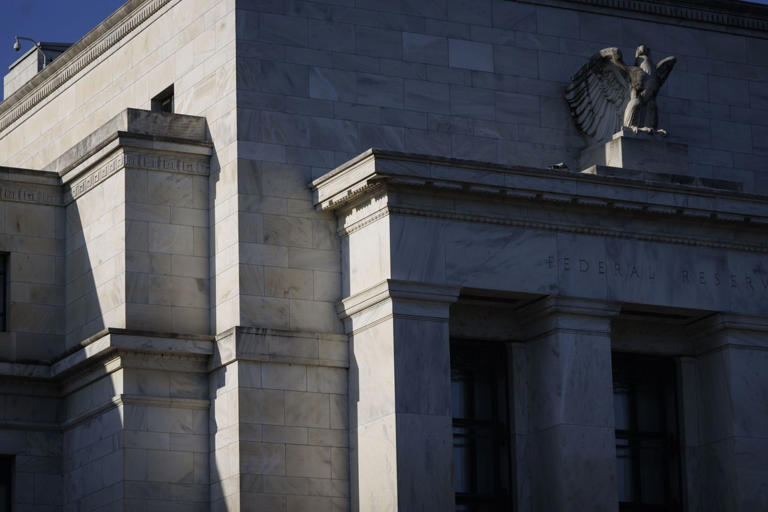Participation in the Federal Reserve’s overnight reverse repurchase facility, commonly known as reverse repo, is declining, signaling potential implications for interest rates and market volatility in the $26 trillion Treasury market.
The reverse repo program allows large financial firms, such as money-market funds, to exchange excess cash for high-quality securities temporarily, earning interest in the process. While the program has seen heavy usage in recent years, with daily balances reaching $2.5 trillion at one point, participation has steadily decreased and recently fell below $500 billion.
Many analysts and portfolio managers anticipate further declines in the program’s usage. This trend is expected to limit the effectiveness of a crucial shock absorber in the Treasury securities market. With the government facing increased interest costs to fund a growing deficit, lower balances in the reverse repo program could lead to heightened market volatility and a rise in interest rates.
According to Michael de Pass, global head of rates trading at Citadel Securities, having a substantial amount of cash in an overnight facility facilitates the absorption of bill supply in the market.
Despite its relative obscurity, reverse repo plays a significant role in the functioning of the financial system and the U.S. economy. Last fall, a Treasury advisory committee proposed that the sizable cash reserves held by money-market funds at the Fed could support a surge in short-term bill issuance. This unusual arrangement has helped keep long-term interest rates relatively low, despite increasing U.S. debt issuance.
Sales of Treasury bills, which mature in a year or less, experienced significant growth during the pandemic and again in 2023. The total amount of T-bills in the market has risen to nearly $6 trillion, a substantial increase from less than $2 trillion at the end of 2017.
While this may appear to be a technical development, it holds significant implications for participants in the global bond market. The surge in short-term debt means that a large portion of this debt will need to be refinanced at higher rates, coinciding with the Federal Reserve’s tightening of benchmark interest rates. While selling bills allows the government to quickly raise cash, it also necessitates difficult decisions regarding how to obtain funds when these bills mature.
Many bond investors believe that the Treasury Department will eventually need to address how it plans to meet its long-term obligations to bondholders, particularly as interest payments become one of the largest expenses in the federal budget.
Despite these challenges, the U.S. has thus far managed to satisfy investors. In November, the Treasury Department addressed concerns regarding investor demand for long-dated Treasurys by selling a significant amount of bills. This move reassured the market and dispelled fears that demand for U.S. debt was declining.
Federal Reserve officials interpret lower usage of the reverse repo facility as a positive sign, indicating that excess cash is being redirected to more attractive investment opportunities in the market. As the reverse repo drains, the Fed anticipates a reduction in reserves within the banking system. Reserves, functioning as electronic cash, are essential for managing transactions among banks, customers, and the central bank.
While the Fed aims to tighten banking conditions to address inflation concerns, the withdrawal of cash from reverse repo by money-market funds injects liquidity back into the economy, offsetting the Fed’s tightening efforts. Officials are cautious about the possibility of reserves becoming significantly scarcer, which could lead to disruptions in the cash markets and potentially spill over into the broader financial system, reminiscent of past events such as the Lehman Brothers’ collapse in 2008 and the onset of COVID-19.
However, not everyone views the decline in the reverse repo cash pile as problematic. According to Jason Granet, Chief Investment Officer at BNY Mellon, Treasury bills can serve as a financing mechanism for the government, accommodating shifts in financing needs based on tax collections and spending requirements. Even in times of recession when government spending may increase, demand for Treasurys typically rises.
The flow of reverse repo funds is also influenced by the substantial inflows into money-market funds, which now hold over $6 trillion in assets. These funds, restricted to highly rated short-term investments, have deposited a significant portion of their inflows into the Fed’s reverse repo facility, earning a competitive overnight rate with minimal risk.
Blake Gwinn, Head of U.S. Rates Strategy at RBC Capital Markets, predicts that a portion of funds will remain in the Fed’s reverse repo facility over time, providing an immediate source of overnight cash. Despite concerns, the Treasury maintains a long-term perspective on funding government operations and is not overly concerned about potential reductions in demand for Treasury bills.
